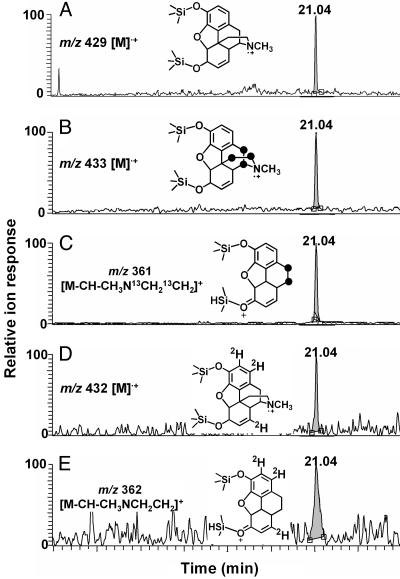Fig. 3.
GC/MS/MS chromatograms of morphine derivatives. (A) The m/z 429 [M]•+ of TMS-morphine isolated from SH-SY5Y cells cultured under standard conditions without isotope-labeled precursor. (B) The m/z 433 [M]•+ of TMS-[9,10,15,16-13C4]morphine isolated from SH-SY5Y cells cultured in the presence of 20 μM l-[1,2,3-13C3]dopa (13C-enriched carbon atoms are indicated by •). (C) The m/z 361 [M - H-CH3N13CH213CH2]+ of TMS-[9,10,15,16-13C4]morphine isolated from SH-SY5Y cells cultured in the presence of 20 μM l-[1,2,3-13C3]dopa. This fragment ion showed loss of two 13C atoms at positions C-15 and C-16 of the morphine molecule and retention of two 13C atoms at positions C-9 and C-10 (13C-enriched carbon atoms are indicated by •). (D) The m/z 432 [M]•+ of TMS-[1,2,8-2H3]morphine isolated from SH-SY5Y cells cultured in the presence of 20 μM l-[ring-2′,5′,6′-2H3]dopa. (E) The m/z 362 [M - H-CH3NCH2CH2]+ of TMS-[1,2,8-2H3]morphine isolated from SH-SY5Y cells cultured in the presence of 20 μM l-[ring-2′,5′,6′-2H3]dopa. This fragment ion showed retention of all three 2H atoms at positions C-1, C-2, and C-8.

